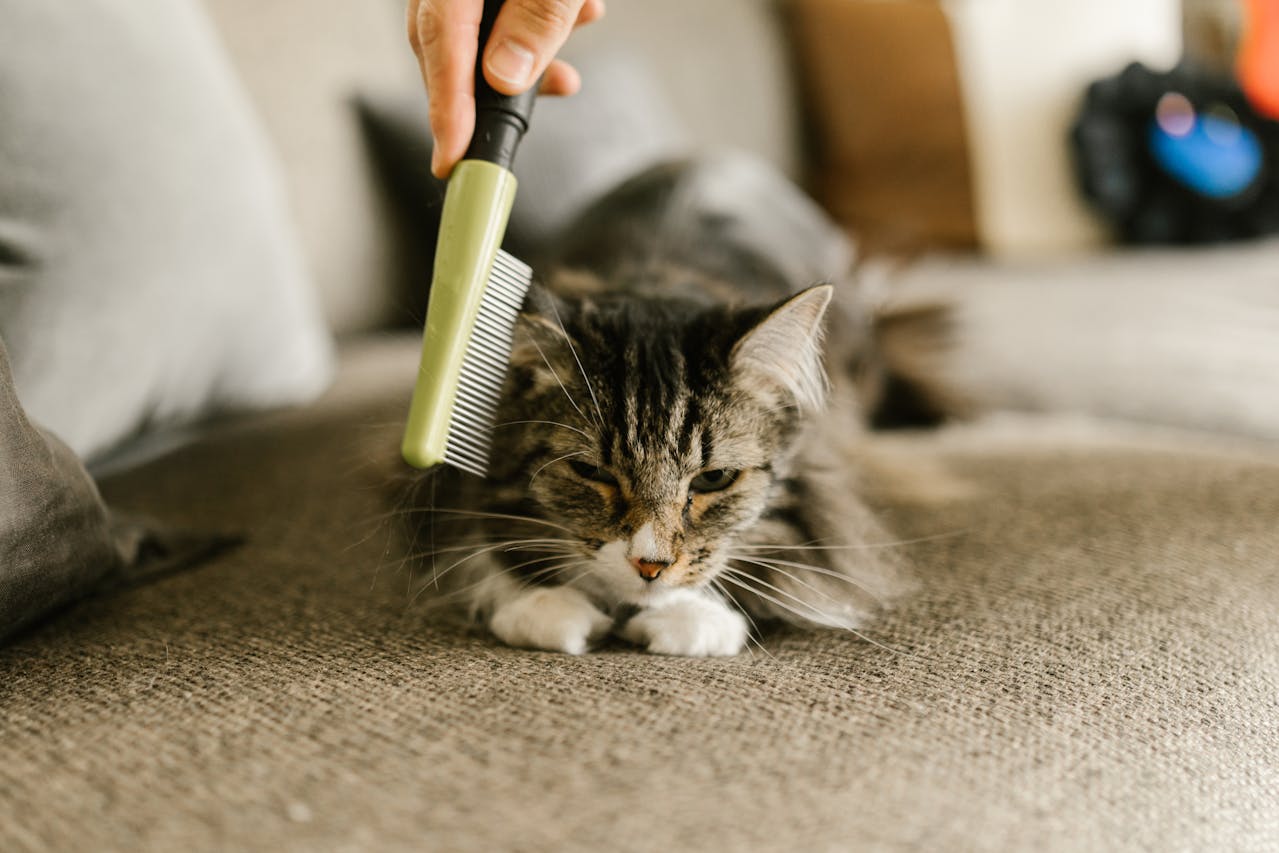Cats
Mar 14, 2025
If grooming your cat feels like entering a battle you didn’t sign up for, you’re not alone. Many cat owners have faced the swipes, hisses, and dramatic flops to the floor just from showing the brush.
Some cats aren’t into grooming, and that’s okay. It doesn’t mean you’re doing anything wrong. Your cat may just have a strong opinion against baths—and a bit of a planning can go a long way.
I’ve seen all kinds of grooming dramas. From the “no-touch” rescue cats to long-haired fluffballs who turn into walking mats overnight, I’ve picked up a few tried-and-true tricks that actually help.
Here are 10 simple tips to make grooming less stressful for you and your cat. Hopefully, in time, your cat will learn to love grooming or at least be more cooperative.
Why Does My Cat Hate Grooming?
Your cat likely hates grooming because it feels uncomfortable, scary, or painful to them.
Many cats—especially rescues or long-haired breeds—don’t enjoy being brushed or handled. Some are still learning to trust. Others may have had bad experiences in the past, or their coat is so tangled that brushing actually hurts. If your cat avoids you the moment you pick up a brush, there’s usually a good reason behind it.
Here are a few common causes why a cat hates grooming:
Their fur is already matted or sensitive
They’ve had a bad grooming experience before
They don’t like being restrained
They might have pain or health issues
The grooming tools don’t feel good

What to Do When Your Cat Hates Grooming: A Step-by-Step Guide
1. Equip Yourself with the Right Grooming Tools
Not all brushes or clippers are made equal. If your cat has long or thick fur, you’ll need a brush that can handle tangles without pulling too hard. For sensitive or short-haired cats, a soft-bristled brush or rubber grooming mitt may feel gentler and less scary. The right tool can mean the difference between a short, peaceful grooming session and a stressful one.
Try different brushes slowly and see what your cat responds to. Some cats prefer being “petted” with a rubber glove instead of a traditional brush. Clippers should feel easy for you to hold, too—especially when trimming nails. Look for ones made for cats, with safety guards to avoid cutting too deep.
2. Begin with a Trial Snip to Gauge Their Reaction
Before diving into a full nail trim, try just one snip and watch how your cat reacts.
Trimming your cat’s nails can help prevent scratches during grooming, but it’s important not to rush it. Gently hold one paw, press slightly to extend a claw, and trim just the very tip. If your cat stays calm, great! Give them a treat and try another. If they pull away or get fussy, stop there and try again another day.
Many cats are frightened by sudden handling of their paws, especially if they’ve never had their nails trimmed before. You can help them get used to it by touching their paws during cuddle time. There are no clippers yet, just calm touches and kind words.
And if you're nervous? That’s okay. It's better to trim just one nail well than to push through and cause stress or injury.

3. Build a Routine They Can Predict—Go Slow
Cats feel safer when they know what to expect, so build a grooming routine they can get used to—slowly and gently.
Start by picking a calm, quiet time of day. Keep sessions short at first, even just a minute or two. The goal isn’t to finish everything right away but to help your cat feel relaxed and in control. You can even begin by simply placing the brush or clippers nearby, letting your cat sniff them without pressure.
Try to groom around the same time and place each week. Routine helps your cat feel more secure. You’re not just grooming—you’re showing your cat that this isn’t something scary, just a regular part of their life.
And remember: it’s okay to take a step back. If your cat walks away, let them. Try again the next day. A calm start leads to more success later on.
4. Start Gentle Brushing Where They Enjoy Being Pet
Begin brushing in the spots where your cat already loves to be touched.
For most cats, that’s the back, cheeks, or under the chin. These areas are often safe and familiar, so your cat is more likely to accept the brush there first. Use light strokes that feel like gentle petting. This helps your cat associate the brush with something pleasant, not stressful.
For now, avoid sensitive areas like the belly, tail, or legs. If your cat tenses up or flattens their ears, pause and try again another day. And don’t forget to speak softly while brushing. Your voice can help keep them calm, just like it would during play or cuddle time.
Over time, as your cat builds trust, you can slowly work your way to other parts of the body. But the key is to go at their pace, not yours.
5. Read Their Body Language and Respect Their Limits
If your cat shows signs of stress, it’s time to pause and give them space.
Cats don’t just meow or hiss. Sometimes, the signs are small—like a twitching tail, flattened ears, wide pupils, or a stiff body. These are your cat’s way of saying, “I’m not comfortable right now.” If you keep going, they might swat, bite, or run off, and the next session could be even harder.
Instead, stop while things are still going well. Even brushing for just 30 seconds is a win if your cat stays calm. Over time, those short, stress-free sessions add up to better progress.
The goal is to help your cat feel safe and listened to. Respecting their limits now builds trust for the next time.
6. Offer Treats for Every Small Success
Give your cat a treat after every calm moment—no matter how small.
Whether they let you touch their paw, sniff the brush, or sit still for a few strokes, reward them right away with something they love. This can be a favourite treat or even a quick play session with a toy.
For rescue cats or those still learning to trust, this positive connection is especially important. You’re not just grooming—you’re showing them that being touched or handled doesn’t have to be scary.
Keep a few treats nearby during each grooming session, and praise your cat in a gentle, happy voice. The more positive moments you create, the more likely your cat will stay relaxed next time.

7. Consider Professional Help When Needed
If grooming at home becomes too stressful or your cat’s fur is badly matted, it’s okay to ask for help.
Some grooming jobs are just too much to manage on your own—especially if your cat is very anxious, has thick mats, or has never been groomed before. In these cases, taking your cat to a professional groomer or your vet is the safest choice. They have the right tools and experience to handle nervous or fearful cats gently.
This doesn’t mean you’ve failed—it means you’re doing what’s best for your cat. A clean, mat-free coat will help your cat feel more comfortable, and once the hard part is done, you can start a calm, simple grooming routine at home to keep it that way.
If you’re unsure where to go, these are the top 10 best veterinary clinics in Dubai with pet grooming services that are good with sensitive or rescue cats.
8. Keep One Paw Out at a Time for Grooming
If your cat won’t stay still during grooming, try wrapping them gently in a towel with just one paw out.
This method, often called the “cat burrito,” helps your cat feel safe and secure without being held too tightly. It works especially well when trimming nails or brushing smaller areas. Lay a towel flat, place your cat on top, then wrap the towel around them so their body is covered, leaving only one paw exposed.
This stops your cat from wriggling away or scratching while still keeping things calm. Speak softly and take your time. After you’ve trimmed or brushed one area, you can switch paws or finish for the day if your cat has had enough.

9. Understand Why Your Cat May Hate Grooming
For many cats—especially rescues or those with long coats—grooming is not just annoying; it can be stressful. If they’ve had a bad experience in the past or if they’re sensitive to being touched, grooming can quickly become something they fear. Some older cats may even have joint pain that makes brushing uncomfortable.
Knowing the reason your cat hates grooming allows you to respond with patience instead of frustration. Understanding the “why” helps you plan better, use the right tools, and go at a pace your cat can handle.
If you’re ever unsure whether your cat’s behaviour is fear or pain-related, speak to your vet. Ruling out health issues can give you peace of mind and make your grooming sessions more positive.
10. Pick the Right Moment—Timing Is Everything
Cats tend to be more cooperative after they’ve eaten or had a good play session. This is when they’re winding down and more likely to stay still. Avoid grooming when your cat is zooming around the house, hiding, or clearly not in the mood. Pushing it during those moments can make grooming harder in the long run.
Choose a time when the house is quiet, and avoid sudden movements or loud sounds. By timing it right, you increase your chances of a smooth session—and you show your cat that grooming doesn’t have to be a battle.

Frequently Asked Questions
1. How do pet groomers handle cats that hate being groomed?
Professional groomers use calm handling, soft voices, and gentle restraint techniques like towel wrapping. If needed, some clinics offer mild sedation under vet supervision for very stressed cats.
2. How long can a cat go without being groomed?
Most cats groom themselves daily, but long-haired or senior cats often need extra help with grooming about once a week. How often to groom a cat depends on their coat type, age, and health. If mats develop or their fur gets dirty, it’s best to book a professional cat grooming session sooner.
3. Is it safe to trim my cat’s nails at home?
Yes, but only trim the sharp tips and avoid the pink part of the nail. If you're unsure, try just one nail first, or ask your vet to show you how.
4. Why does my cat panic when I use a brush?
It could be the wrong type of brush, or they might associate it with past discomfort. Try a softer grooming glove and introduce it slowly during calm moments.
5. Can I bathe a cat that hates water?
Bathing isn’t always needed, especially for healthy indoor cats. If your cat is very dirty or has skin issues, use a damp cloth or seek a groomer trained in handling fearful cats.





